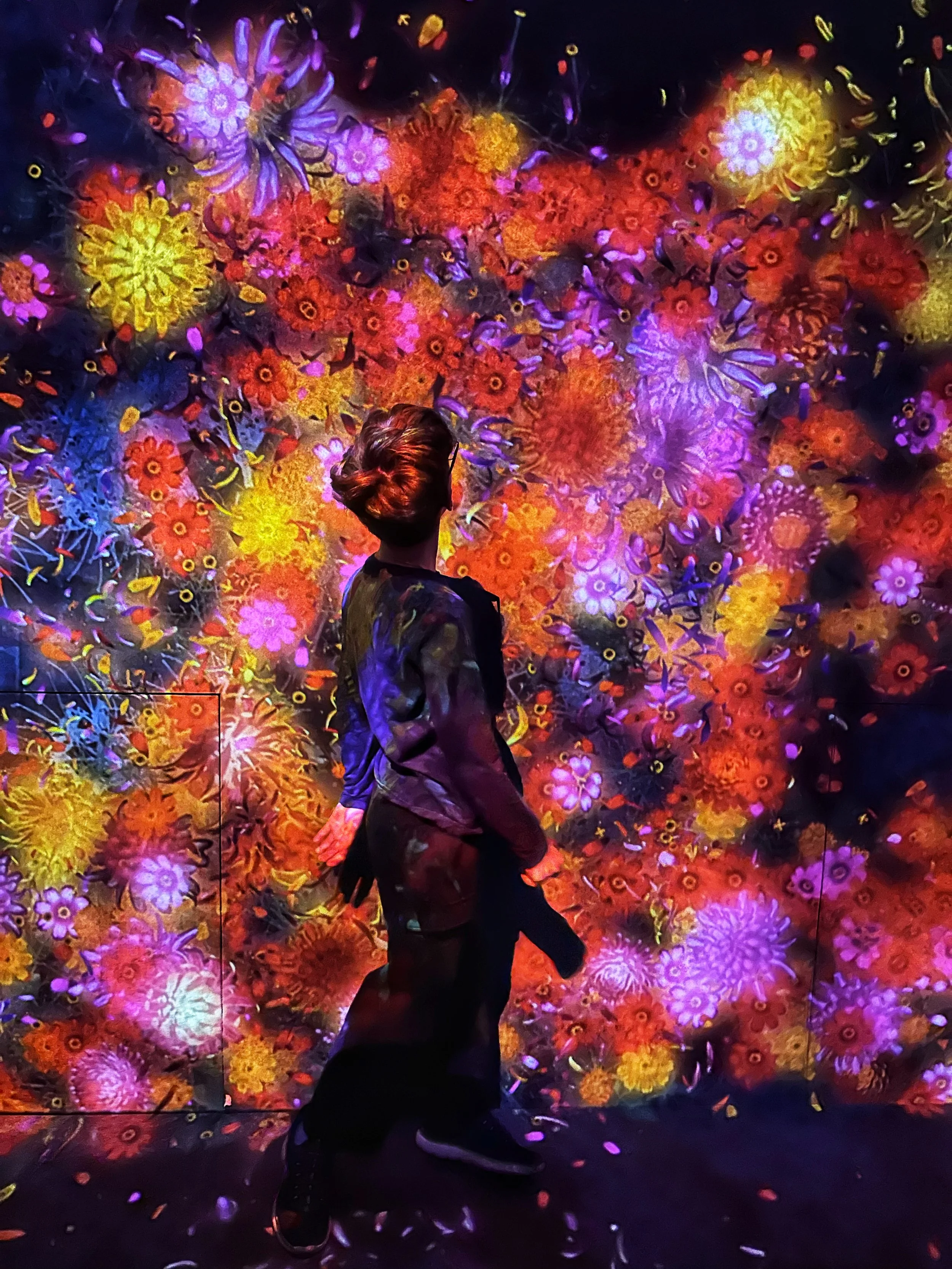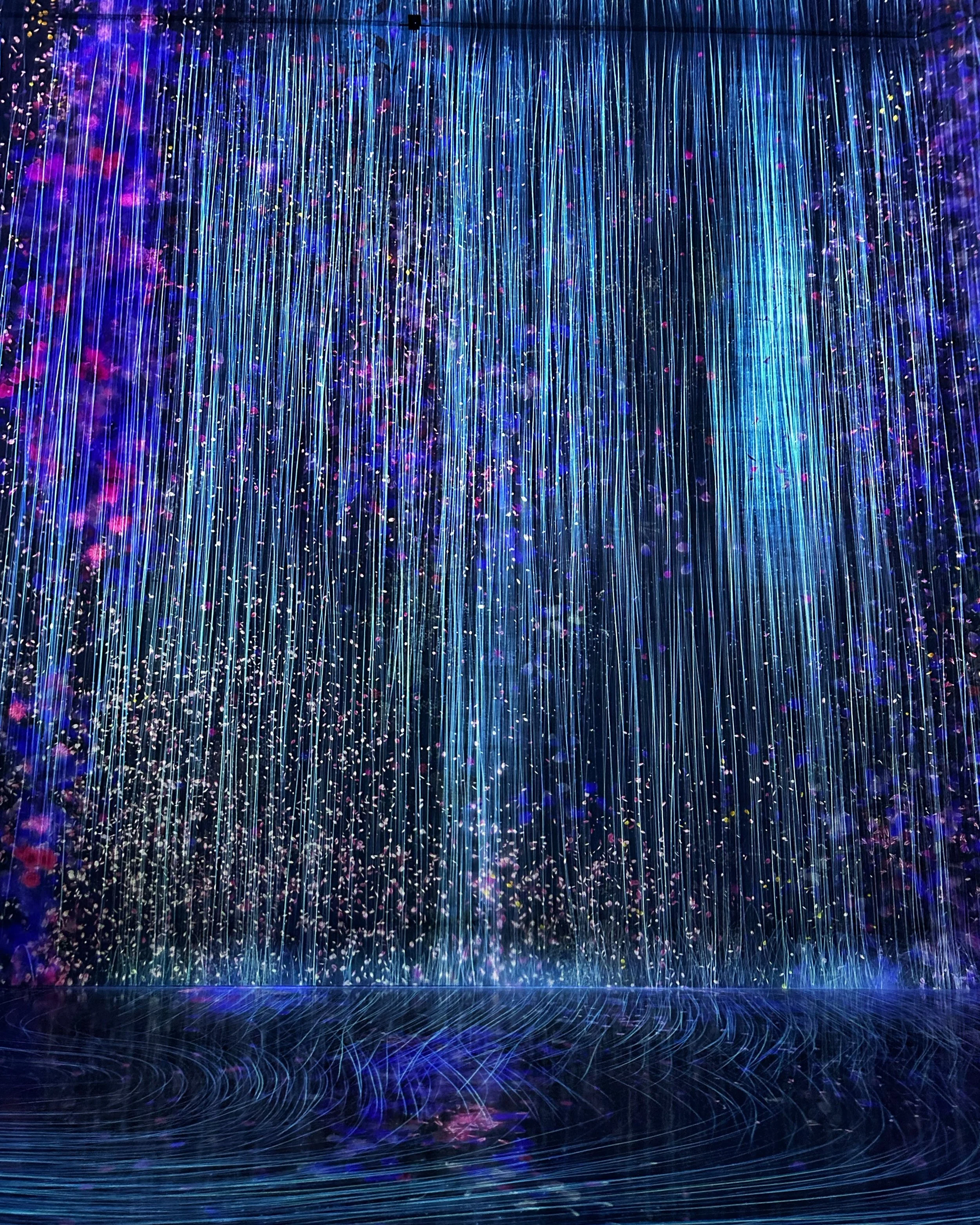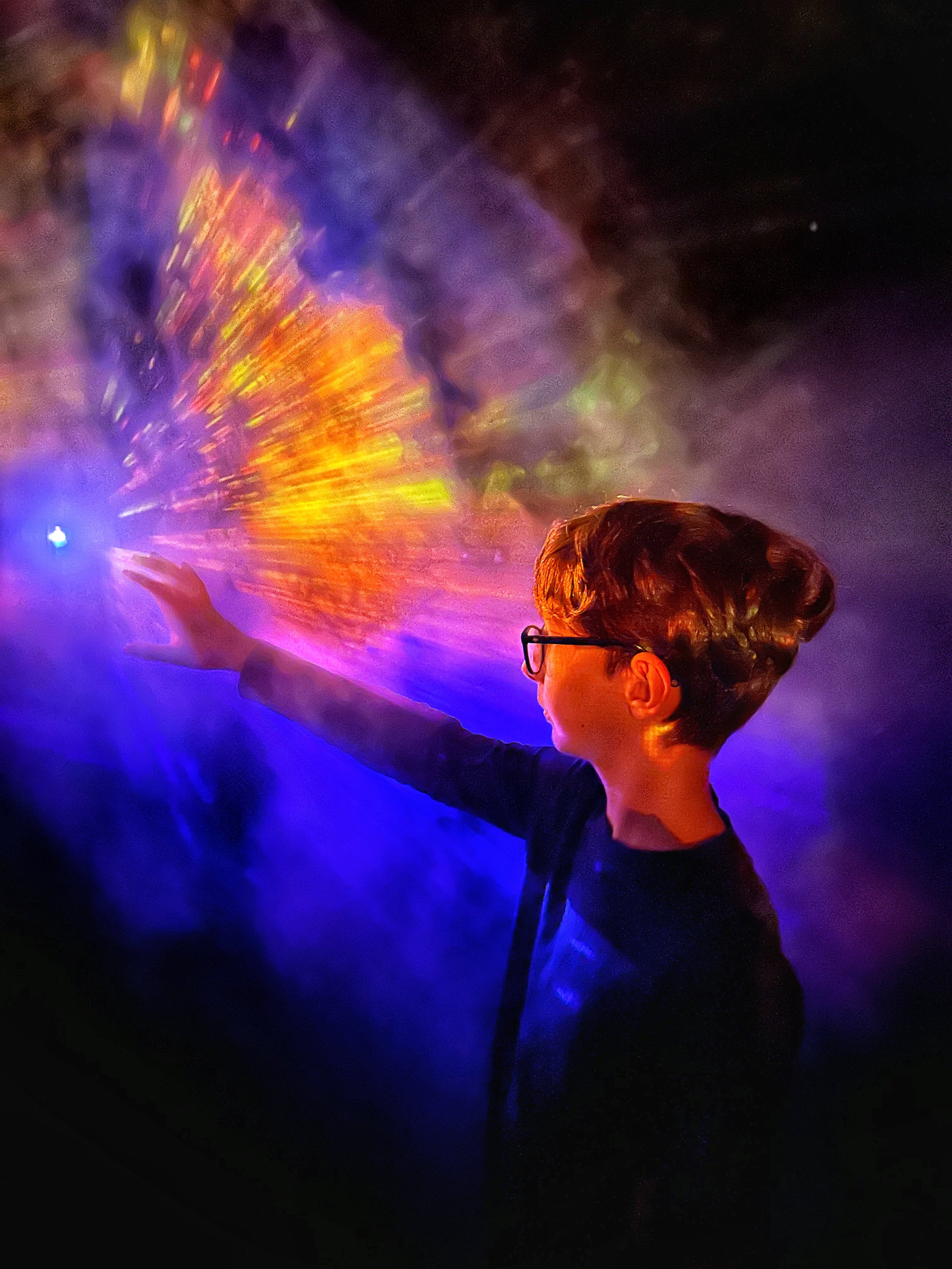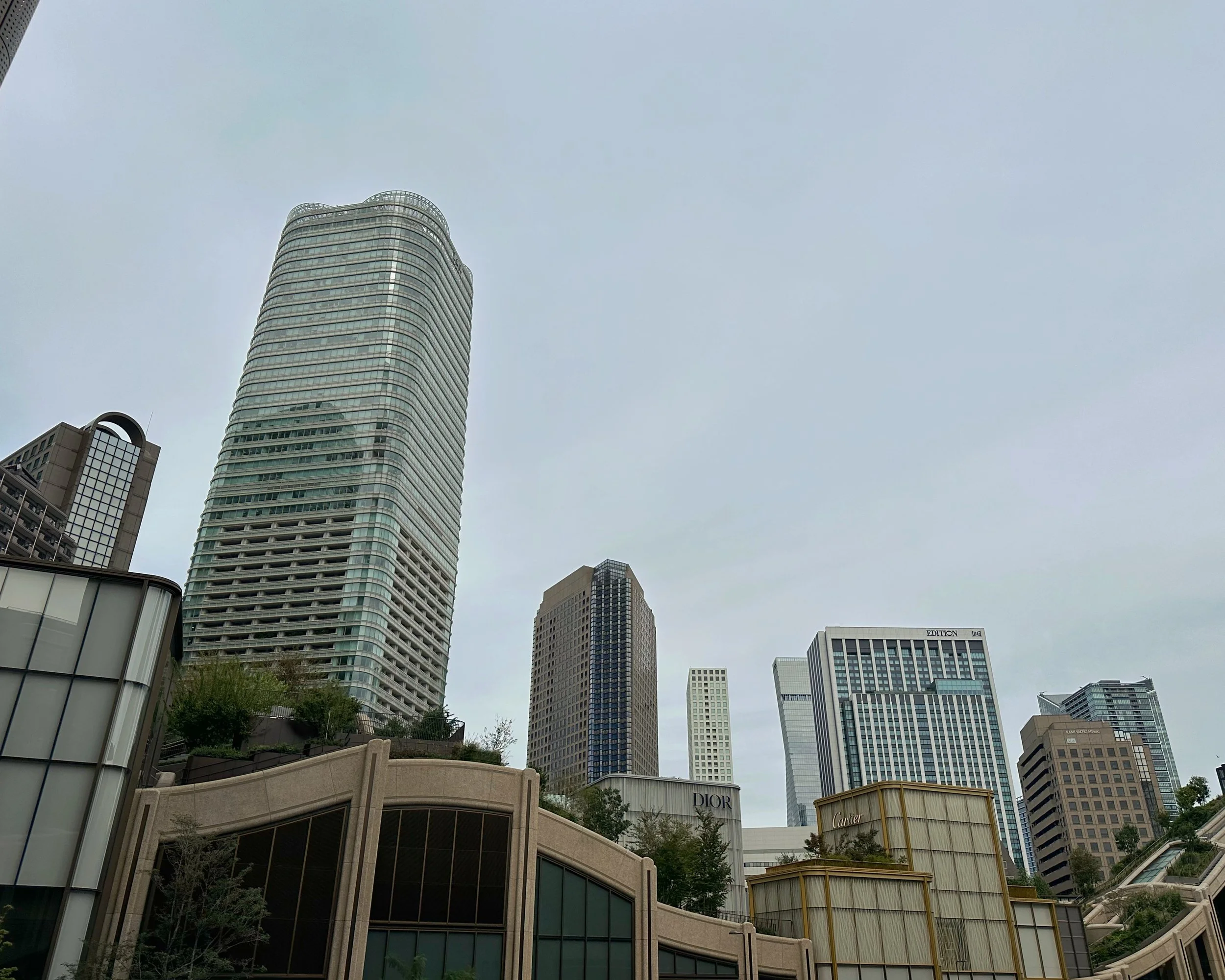Tokyo, Japan (2025)
Getting There
In October 2025 we visited Tokyo for 6 nights – our second trip to Japan, following our first in April 2023.
In 2023 we had 3 weeks and explored many places across the country.
The aim this time, with just 1 week, was to focus on revisit areas of Tokyo we’d particularly enjoyed last time and visit neighbourhoods we hadn’t seen before.
We flew with Air China from London Gatwick to Shanghai, then onwards to Tokyo Narita. With a three-hour connection in Shanghai, the total journey time was 17 hours.
Our economy tickets included a generous checked baggage allowance of two 15kg bags each – far more than we needed. We checked two backpacks weighing under 9kg each and brought small under-seat bags with snacks, water and electronics.
These indirect Air China flights cost £2,000 for the four of us. In comparison, direct economy flights with British Airways or Japan Airlines on the same dates were around £5,500.
We’d read a few horror stories about Air China, but for a low-cost carrier we were pleasantly surprised. The staff were helpful, the food was decent, and the planes – including the toilets – were clean.
The connection in Shanghai was the only drawback. Even though we were only transiting and remained airside, we still had to go through a passport check, temperature check and full security scan of our hand luggage.
Security took particular interest in our power packs, but after inspection they let us keep them. By the time we’d cleared all the checks, we had about 40 minutes left before boarding. We wouldn’t have wanted a shorter connection, but given the money saved, it was a fair trade-off.
From Narita Airport it was an easy journey into Tokyo. We took the one-hour SkyAccess train direct to Asakusa Station, just a five-minute walk from our accommodation.
We used SUICA cards (the kids had physical cards from our previous trip and we added digital cards to the apple wallets on our phones) to pay for public transport.
These IC cards can be used to pay for transport across Japan and this integrated ticketing system makes it really easy to get around. We spent around £100 on public transport during our time in Tokyo (about £4.85 per adult and £2.50 per child per day).
Taxis are not an efficient or particularly affordable way to get around the city. We did take two taxis during our trip, when we just couldn’t face walking any further or taking the subway. A taxi from Ginza to Asakusa cost us five times as much as the subway ride would have and took about the same amount of time.
Accommodation
We stayed in Tokyo for seven nights. The Mimaru chain of apart-hotels offers the privacy, amenities and space of self-catering accommodation, but with the bonus of a hotel-style front desk and cleaning service.
Mimaru has various apartment sizes and layouts across Japan. In 2024 we stayed at the Asakusa Station branch, where we had a compact apartment with a single space for sleeping, sitting and eating (the kids had bunk beds).
This time we chose a larger two-bedroom apartment at the Asakusa Suites branch. It had two separate bedrooms, a living room with sofa, breakfast bar and coffee table, a shower room, bathroom, and washer/drier.
The Suites branch overlooked the railway lines, making it quite noisy. Even on the 12th floor we could hear trains, river boats and sirens. The apartment did, however, have a great view of the Skytree across the river – when it wasn’t hidden by clouds.
Tourism in Japan has surged, with a record 36 million visitors in 2024. As a result, hotel prices have risen sharply. Our apartment at Mimaru Suites cost a budget-stretching £350 per night – about 33% more than we paid when Japan had just reopened after Covid and tourism was still recovering in early 2023.
Our star rating: 5
Our cost rating: 3
We stayed in Asakusa, home to Senso-ji, Tokyo’s oldest temple, the neighbouring Asakusa Shinto shrine, and Kappabashi kitchen district, where shops sell every kind of catering equipment imaginable.
Tenugui are small pieces of lightweight cotton dyed with colourful patterns and pictorial scenes. Traditionally they are used as washcloths, headbands, gift wrap and bags, or as decoration. We sought out different designs with the aim of hanging them as wall art back home. We purchased a selection from three shops in Asakusa - Fujiya, Kamawanu and Someno-Anbō Asakusa Honten.
Asakusa is busy with tourists like us - buying souvenirs and visiting the temple during the day. But by late afternoon, as the shops close, the area becomes calm and peaceful. In the evenings we’d wander out for supper, choosing a different place each time. We stuck to busy spots and avoided anywhere with scouts trying to lure in tourists – and didn’t have a bad meal the whole trip.
Day 1 - Togoshi and Musashi-Koyama
We were all awake by 5am on our first morning (thanks, jet lag). Most shops in Tokyo stay closed until 10 or 11am, even on Saturdays. So we spent the first few hours relaxing in the apartment before heading out mid-morning to Togoshi and Musashi-Koyama in Shinagawa, in the south of Tokyo.
We’d asked on TripAdvisor for suggestions of lesser-known areas, and the forum’s ‘destination expert’, Dr Shibuyakko, recommended this part of the city. Thanks, Dr S!
Togoshi Ginza (easy to reach on a direct subway train from Asakusa) has thrift shops, local stores and street food stalls selling yakitori (chicken skewers), korokke (crispy croquettes stuffed with mashed potato), fried chicken and gyoza dumplings.
As well as sampling the korokke, we had an excellent lunch at a small, unassuming bar where the owner kindly helped us navigate the ordering machine and make sensible choices.
William tried pork ramen with a range of toppings – including little pieces of pork fat and a soft-boiled egg – that gave the broth an incredible depth of flavour. Mal and Max had soba noodles with hot broth (spicy and mild respectively), the cold noodles contrasting beautifully with the steaming soup. Harriet had delicious, freshly made gyoza bursting with flavour.
After lunch, we wandered back along Togoshi Ginza. Togoshi’s mascot, Ginjiro, appears as statues outside shops and hangs from lampposts, brightening the street. Photographed here in their Halloween garb.
From Togoshi we walked to Musashi-Koyama, home to Tokyo’s longest covered shopping arcade. Like Togoshi, it also has mascots – smiling beavers named Pal-Chan and Pam-Chan.
Neither area is touristy or trendy; both are full of ordinary families shopping for practical homewares, electronics and clothing. We liked the suburban feel and seeing locals going about their weekend routines.
Day 2 - Kuramae and Akihabara
Neighbouring Asakusa to the south, Kuramae is noticeably sleeker and more modern. It attracts a younger, fashionable crowd drawn to its stylish cafés and designer shops.
On Sunday we explored on foot, browsing stores selling homewares, furniture, stationary and clothing. Koncent sold beautiful things and innovative products for the home.
Mt. Lab was a stunningly presented shop dedicated to washi tape. MAITO / Kusu Kuramaehonten sold gorgeous (and pricey) clothing made from hand dyed yarn. Kakimori offered custom made notebooks and an array of stationary. At most of these shops we just browsed and coveted, but we did pick up some small purchases of washi tape and pens.
We stopped for a rest at the Dandelion Chocolate Factory and Café, where the intoxicating smell of cocoa hit us as soon as we stepped inside. We ordered hot chocolates for the kids, an iced chocolate for Harriet, and a chocolate chip cookie to share. Everything was delicious but far too rich and bitter for the children – definitely grown-up indulgence.
From Kuramae, we walked about 20 minutes to Akihabara, Tokyo’s hub for gaming, anime, gachapon and maid cafés.
It was Sunday afternoon and absolutely packed. The noise, lights and sheer number of people were overwhelming. We browsed anime shops and played arcade games at Super Potato and Giga 3, but the sensory overload soon became too much. We retreated to our apartment for a quiet evening.
Day 3 - Kamakura and Yokohama
Originally, we’d planned a day trip to Nikko to see the autumn leaves and waterfalls around Senjogahara Marshland and Lake Chuzenji.
We’d been tracking the colours via recent Google Maps photos and leaf forecasts for weeks, and had bought our limited express train tickets and Tobu bus passes a month in advance.
By the end of day two, though, we realised none of us had the energy for a full day involving a two-hour train and a winding, hour-long bus ride each way. The thought of slow moving traffic and crowds didn’t appeal either.
So, we cancelled our tickets for a refund. Missing Nikko gives us a good excuse to return to Japan – next time perhaps exploring further north to Yamagata, Yamadera Temple, Sendai and Matsushima Bay.
The kids were visibly relieved, and instead we decided to visit the seaside town of Kamakura and the city of Yokohama.
We set off around 9am, after the morning rush hour, taking three trains: from Asakusa to Shinagawa, then to Kamakura, and finally to Hase on the charming Enoden electric railway. The whole journey took about 90 minutes.
From Hase station, we walked ten minutes to Kotoku-in Temple, home to the impressive 11-metre-high Great Buddha. It was fun to step inside the bronze statue, though the grounds were small and the original temple buildings that once sheltered the Buddha had long since collapsed.
Next, we visited nearby Hasedera Temple, which offered more to explore. The complex included both Buddhist and Shinto buildings, peaceful gardens and a hillside walkway with stunning views of the town and ocean below.
Afterwards, we caught the Enoden train back to Kamakura town centre for lunch at a fantastic ramen bar called Thank. The friendly staff and delicious food – chicken noodle soup and spicy dan dan noodles – were just what we needed.
We then wandered along Kamakura’s main high street, browsing shops selling everything from stationery and art prints to sweets, hats, clothing and ornaments.
We bought a pretty calendar on textured paper, a new hat for Mal, and gachapon toys and stickers for the kids and friends back home.
The boys also tried crepes at Crepe Shop Coquelicot – chocolate and cinnamon for William, lemon and sugar for Max. Ordering via a vending machine was novel, though it took a while for the queue to reach the serving counter. The kids declared them worth the wait.
Some travellers say Kamakura is a good substitute for Kyoto. While we could see the similarities – temples, greenery and small shops – it’s not quite on the same scale. Still, we really liked Kamakura’s laid-back seaside feel. It was touristy but far less crowded than Kyoto, and the temples and ocean views made for a lovely day.
By the time we returned to Kamakura station it was about 3.30pm, and we were all tired with sore feet. Still, we pressed on to Yokohama.
We took the train to Yokohama, changed to the Minatomirai line, and reached Nihon-Odori station around 4pm, just before sunset.
Chinatown was buzzing with street food stalls and busy restaurants. We sampled some dim sum, which was fine but not the best, and had to chase up missing dishes more than once.
From there we strolled to Yamashita Park as dusk fell. The waterfront was lit up beautifully, and the skyline of skyscrapers and the amusement park looked stunning.
We walked along to the Red Brick Warehouse, where the kids, completely shattered, shared a slice of apple pie and tea with Harriet at Granny Smith, while Mal explored the shops.
Architecturally and conceptually, the Red Brick Warehouse reminded us of Salts Mill in Shipley, West Yorkshire, though Mal thought the shops were oddly old-fashioned and pricey. The products were not our thing and seemed aimed at affluent cruise ship tourists, with a retro Americana vibe.
By 7.30pm the kids were fading fast, so we made our way back to Asakusa. Both fell asleep on the train after a day of over 20,000 steps – full of temples and treats.
We reached the apartment around 9pm, ready for baths, stories and bed. Once the kids were asleep, we had tea and biscuits while trying to watch Only Connect and University Challenge – our Monday night ritual.
After a few minutes of confusion with the VPN, we remembered the nine-hour time difference with the UK. Those episodes would have to wait. Instead, we read, drew, and worked on the blog before going to sleep – ready for another busy day in Tokyo.
Day 4 - Koishikawa Korakuen Garden and Ginza
A more laid-back day today.
Leaving Mal and the boys to relax at the apartment in the morning, Harriet visited Koishikawa Korakuen Garden. The subway station at Iidabashi had a striking design, with a cool light installation outside and interesting architecture at the entrance.
Koishikawa Korakuen is a beautiful, peaceful garden laid out around a large pond. The little waterfall and stepping stones were charming.
It was still a little early for the bright reds and oranges of autumn, but some trees were starting to turn and show hints of colour.
In the afternoon we took the subway to Ginza and had lunch at Kura, a conveyor belt sushi restaurant. It was great fun to order a dish and have it whizz to us on a plate rollercoaster.
After eating, we wandered around Ginza. This upmarket area stands in stark contrast to Asakusa, with its skyscrapers, designer stores and supercars aimed at the wealthy.
We did some clothes shopping at the Uniqlo and Muji flagship stores and had a cup of tea in the Muji diner before heading back to the apartment.
Day 5 - Azabudai and Roppongi
This was our last full day in Tokyo. We had booked tickets to TeamLab Borderless at Azabudai Hills.
On our first trip to Japan we visited TeamLab Planets, and we have also been to a TeamLab exhibition in Aarhus, Denmark. Both were fantastic, so we had high hopes for Borderless.
Borderless did not disappoint. There is intentionally no map or set route through the exhibition. The art flows across different spaces, and the combination of visuals and music put us all into a bit of a trance.
Our favourite spaces were those that offered multiple sensory experiences.
Memory of Topography was absolutely stunning, guiding us from beneath a lily pond up to the surface and down a hill reminiscent of a rural mountain or rice terrace, surrounded by beautiful golden light.
Universe of Fire Dissolving Flames was basically dry ice and coloured light, but it felt wonderfully surreal to watch our hands and arms disappear into the mist.
The crystal room was similar to the one at TeamLab Planets. It was breathtakingly pretty, with collective gasps of awe when the lights changed. We soon realised we could use the app to change the display, which entertained the kids for ages as they cycled through the options, enjoying their control over the art.
After TeamLab we went to the top of Mori Tower to the Sky Café to check out the view.
The café charges 500 yen (£2.50) per person to enter, and everyone must order a drink. We had tea, hot chocolate, two fruit juices, two doughnuts and a croissant.
At £35 (7,000 yen) this was the most expensive café we visited on the trip. The view of Tokyo Tower was good but not really worth the price, and as we later discovered, there are really good further reaching views at Roppongi Hills. We would recommend skipping this café.
After Azabudai Hills we went to Roppongi Hills. We had a delicious lunch at a Korean barbecue on the fifth floor, which introduced us all to some new flavours and dishes.
After lunch we visited the Mori Art Gallery on the top floor. Tickets cost 2,300 yen (about £11.50) per adult, and children go free.
The exhibition on Sui Fujimoto’s architecture was excellent, full of models and sketches showing the design process and final results. We added a few places to our list for future visits, such as the concert hall in Sendai.
At the end, a children’s area invited kids to make drawings and models of buildings or use blocks to create their own designs. The museum shop had a lovely selection of art and design products.
The museum is on the 53rd floor, so there are plenty of views without paying extra for the observatory.
We would definitely recommend skipping the pricey café at Azabudai Hills and visiting this brilliant gallery instead.
The next two exhibitions, on Evangelion (an anime show) and Machu Picchu and the Artistic Treasures of Peru, both look worth visiting.
Day 6
This was our last, not-quite-full day in Tokyo. We spent the morning slowly waking, packing up our things, charging our electronics, tidying the apartment, reading and writing this blog.
We walked to Kappabashi, a street full of shops selling knives, ceramics and catering equipment, and ate lunch in Asakusa, before taking the train back to Narita airport to begin the long journey home.
The queue at Narita for Air China check in desks was very long but they processed everyone eventually and security was efficient and quick. On the return leg the transfer at Shanghai was straightforward. We landed in China at 10pm to a nearly deserted airport with short queues. Our 4 hour connection time was more than ample this time.
Final thoughts
It was a joy to be back in Japan, surrounded by familiar sights and with a better understanding of cultural norms on this repeat visit. Asakusa was a great base for us again, and we feel we know it well now. When we returned to the area and apartment after a long day, the kids referred to it as going home.
We enjoyed exploring new places, including Togoshi, Musashi-Koyama, Kuramae, Kamakura and Yokohama.
We did much more shopping this time, taking advantage of the generous Air China baggage allowance. We bought clothes, stationery, gachapon toys and textiles, both for ourselves and as gifts. We preferred the small boutiques of Kuramae and Asakusa to the high-end glamour of Ginza and Roppongi.
Temples, gardens and museums were a delight, especially Hasedera temple, the Mori Art Museum and Koishikawa Korakuen Garden.
Tokyo is an incredible city, but it is also a sprawling grey mass, and we found ourselves missing the peace, beauty and greenery of Kyoto. It was a shame we did not make it to Nikko, but given our limited time it was the right decision. It does, however, give us another reason to return to Japan in the future.
A final note on public transport, which remains astonishingly good. Few cities come close to Tokyo’s reliable, efficient, clean, affordable and integrated system. From the tinkling jingles that play at each station, a different tune for every line, to the arrows on the floor showing exactly where to queue, to everyone taking their rubbish home — travelling by train in Tokyo is full of charm.































































